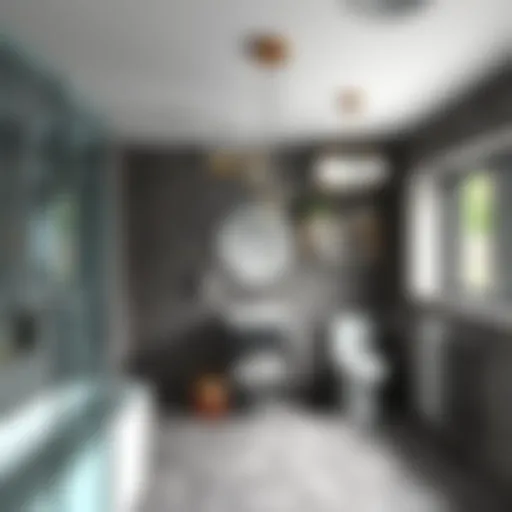Efficient Paint Removal Techniques for Wood
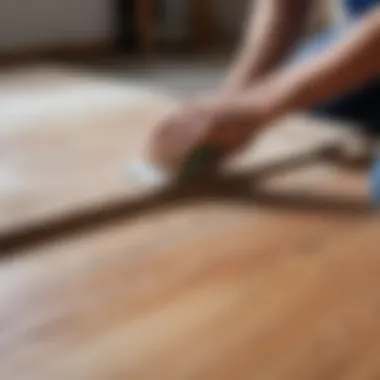

Intro
Removing paint from wooden surfaces can be a daunting task for many homeowners. This is particularly true for those who value the natural aesthetics of wood and wish to maintain its integrity while restoring its appearance. The process is not just about stripping paint; it involves careful planning, the right choice of materials, and appropriate techniques that protect the wood from damage. By understanding effective methods, one can transform a neglected piece of furniture or a wooden fixture back to its original charm.
This article will delve into the essential steps for paint removal. From the initial project planning to selecting suitable tools and safety measures, every stage is critical for achieving a successful outcome. We will also explore various techniques to preserve the wood’s natural character, ensuring that the results meet the expectations of DIY enthusiasts, interior designers, and builders.
Проектирование и планирование
Planning is the foundation of any successful DIY project, especially when it involves intricate wooden surfaces. Before diving into the paint removal process, assess the project thoroughly.
Как выбрать проект для DIY
Choosing the right project starts with evaluating which items need attention. Is it an old chair, a table, or perhaps baseboards? Each piece may require different methods based on the type and age of paint as well as the wooden substrate. Ensure that the project aligns with your skill level and available time, so you can approach it with confidence.
Оценка времени и ресурсов
Estimate the time required for your project. Factors include the size of the object, the type of paint used, and the desired finish. For example, removing multiple layers of paint may necessitate several hours or even days. It is wise to allocate extra time for the unexpected. Additionally, gather all necessary resources, including tools and safety equipment, before starting to prevent interruptions.
Выбор материалов
The materials chosen for paint removal significantly impact the process and outcome. Understanding which products to use can save time and effort while ensuring the preservation of the wood.
Типы материалов для различных проектов
Different methods involve various materials, each suitable for specific projects:
- Chemical Strippers: Effective for multiple paint layers but may require careful application and disposal.
- Heat Guns: Useful for thick layers of paint, but they can burn the wood if not used correctly.
- Sanding Equipment: Offers a mechanical method for paint removal but can scratch or damage softer woods.
Советы по покупке и экономии
When purchasing materials, consider the following tips:
- Look for reputable brands known for paint removal solutions. Brands like Citristrip and Klean-Strip offer reliable products.
- Check local hardware stores for sales or discounts on supplies.
- Consider borrowing tools from community members if you do not foresee using them in the future.
"Planning and material choice are critical for successful paint removal. Skipping these steps can lead to poor results and potential damage to the wood."
By methodically planning your project and carefully selecting your materials, you set a solid groundwork for effectively removing paint from wooden surfaces. Engaging in this process with due diligence will enhance your chances of achieving a satisfactory and aesthetically pleasing result, preserving the wood in the process.
Preface to Paint Removal
Removing paint from wooden surfaces is a significant task in home improvement, and it often requires careful consideration. The process involves not just eliminating unwanted paint but also preserving the quality and texture of the wood. It is essential to understand the underlying need for paint removal, which can range from aesthetic upgrades to restoration of antique furniture.
The techniques employed can vary widely. An effective paint removal strategy can enhance the overall appeal of a space. However, improper methods can lead to irreversible damage. Therefore, recognizing the various paint types prevalent on wooden surfaces is crucial. This section will focus on essential aspects that guide individuals through efficient paint removal with minimal risk to the wood beneath. The insights shared here strive to equip DIY enthusiasts and professionals alike with the knowledge to tackle such projects competently.
Understanding the Need for Paint Removal
Paint removal can be necessary for several reasons. One common motivation is aesthetic. Over time, paint can fade, chip, or become discolored. Removing old paint allows homeowners to revitalize their space with a fresh look. Additionally, peeling paint can be an eyesore and may negatively affect the home's value.
Another reason is related to the preservation of wooden structures. In some cases, paint may trap moisture and lead to wood rotting or damaging the surface. Therefore, stripping paint can be a proactive measure to maintain wood quality.
Moreover, with changing trends and preferences, homeowners often wish to update their interiors. Understanding the various aspects that necessitate paint removal helps in selecting the right technique and tools for the job.
Types of Paints Common on Wooden Surfaces
Paint on wooden surfaces can primarily be categorized into two types: oil-based paint and water-based paint. Each type comes with its unique characteristics, which affect the methods of removal.
Oil-Based Paint
Oil-based paint is known for its durability and resistance to wear. This type of paint creates a hard finish which, while attractive, can be challenging to remove. Its thick consistency often results in rich colors, making it a popular choice among designers. However, the removal process can be labor-intensive due to the robust bond it forms with wood. Users often need to apply chemical strippers or abrasive techniques to strip it effectively.
This type of paint is beneficial in situations where longevity is essential. However, it has a downside, particularly in terms of odour and fumes during application and removal. Health and environmental concerns are considerable with oil-based paints, which should be taken into account during projects involving this type of paint.
Water-Based Paint
Water-based paint, in contrast, has gained popularity due to its ease of use and lower environmental impact. It dries quicker than oil-based options, which suits many DIY projects. One of the biggest advantages of water-based paint is that it tends to peel off more readily than oil-based paint, simplifying the removal process.
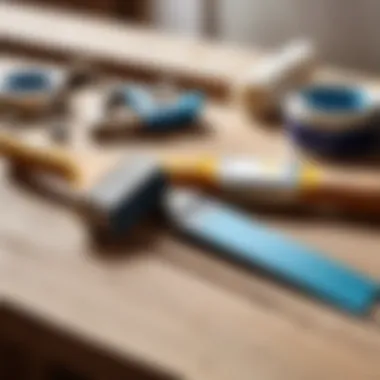

Its unique features include lower volatile organic compounds (VOCs), which promote a healthier indoor air quality. However, water-based paints may not share the same durability as oil-based paints, affecting their longevity on surfaces exposed to wear. Despite these challenges, their ease of cleanup and less harsh removal processes make them a favored choice for many home improvement projects.
Safety Precautions to Consider
When engaging in paint removal from wooden surfaces, it is imperative to address safety precautions. Taking the necessary steps to ensure personal safety can prevent adverse health effects and avoid accidents. The nature of paint removal can involve hazardous chemicals and dust, which may pose risks if proper measures are ignored. By prioritizing safety, one can focus better on the task at hand while minimizing health risks. The following sections outline critical aspects that should be addressed.
Personal Protective Equipment
Gloves
Using gloves is essential when handling paint removers. They protect the skin from chemical burns and irritants that may be present in paint stripping products. The right gloves should be resistant to solvents, making materials like nitrile or neoprene good choices. Some gloves also provide a better grip, which is crucial while working with tools. However, selecting gloves that fit properly is important; ill-fitted gloves can lead to accidents or injuries. Also, gloves should be frequently checked for signs of wear and replaced as necessary.
Mask
A mask is another vital component of personal protective equipment. Paint and solvents often release harmful vapors that can be toxic if inhaled. A good mask should ideally have filters that can protect against organic vapors. One common choice is an N95 respirator, which can filter out particles while providing comfort for longer usage times. It is crucial to ensure that the mask fits tightly on the face to prevent inhalation of harmful substances. On the downside, wearing a mask could feel uncomfortable, especially in hot environments, so take necessary breaks when needed.
Safety Goggles
Safety goggles are important to shield your eyes from debris, splashes, and harmful chemicals. They create a barrier around the eyes, preventing any accidental contact with irritating substances. Selecting goggles that include anti-fog capability can ensure clear visibility, especially during lengthy tasks. The use of regular glasses is not sufficient, as they do not provide the necessary side protection. Though safety goggles may feel bulky, they are crucial in preventing serious injuries that could occur during the paint removal process.
Ventilation Requirements
Proper ventilation is important when removing paint, as it helps disperse harmful vapors and reduces the concentration of toxic substances. When working in enclosed spaces, use fans or open windows to promote airflow. If possible, performing tasks outdoors can be more beneficial. Furthermore, if you are using chemical strippers or paints with strong odors, ensure enough fresh air circulates through the area, reducing the risk of respiratory issues. It's also wise to take breaks in well-ventilated areas to minimize exposure. Looking out for signs such as dizziness or headaches can indicate inadequate airflow. Taking these precautions not only protects your health but also improves the overall effectiveness of your paint removal project.
Tools and Materials Needed
Removing paint from wooden surfaces requires specific tools and materials to ensure the process is effective and safe. Understanding the right tools not only streamlines the cleaning process, but it also helps in preserving the integrity of the wood. Proper tools can reduce damage and maintain the quality of the surface underneath the paint. In this section, we will focus on the primary categories of tools and the implications of each.
Chemical Strippers
Chemical strippers are essential for many home projects involving paint removal. These products work by breaking down the paint's bond with the wood, making it easier to scrape off. The effectiveness of these strippers varies based on their formulation and the type of paint they are designed to remove.
Types of Chemical Strippers
There are two main types of chemical strippers: solvent-based and caustic-based. Solvent-based strippers are popular as they are effective at removing oil-based paints. They can penetrate deeper into the paint layers, which often leads to easier removal. Caustic-based products work well on water-based paints but may require more effort depending on the number of paint layers.
Key characteristics of chemical strippers:
- Solvent-based Strippers: Generally effective for hard paints, deeper penetration.
- Caustic-based Strippers: Better for water-based paints, may need multiple applications.
While solvent-based strippers are known for their efficacy, they can also pose hazards due to strong fumes. Proper ventilation is essential when working with these products to avoid inhaling toxic chemicals. On the other hand, caustic-based products might be less hazardous but can be harsh on the wood if not monitored closely.
Choosing the Right Product
Selecting the appropriate chemical stripper is crucial for success. Different strippers suit various paint types and wood conditions. When choosing a product, consider the original surface finish, the thickness of the paint layers, and the product's safety profile.
Key characteristics of choosing the right product:
- Compatibility: Ensure the stripper is suitable for the type of paint.
- Safety Rating: Review the safety data sheets for each product.
A strong product that works on one type of paint might not be effective on another. This knowledge is vital to avoid wasting time or damaging the wood surface further. It may also be advantageous to conduct a small patch test on the wood area to confirm product effectiveness before fully committing.
Mechanical Tools
In addition to chemical strippers, mechanical tools are crucial when removing paint from wood surfaces. They provide manual assistance in the scrubbing, scraping, and sanding phases of the paint removal process.
Sanding Tools
Sanding tools like electric sanders or manual sandpaper play a significant role in the removal of paint residues after the chemical treatment. These tools allow a smooth finish while ensuring any leftover paint is removed.
Key characteristics of sanding tools:
- Electric Sanders: Fast and efficient, useful for large areas.
- Manual Sandpaper: Offers precision, ideal for intricate details or small areas.
Sanding tools help achieve the desired surface quality. However, it is crucial to use the right grit; finer grits follow after the heavier sandpaper to avoid scratching or damaging the wood. Over-sanding can also lead to uneven surfaces and visible damage.
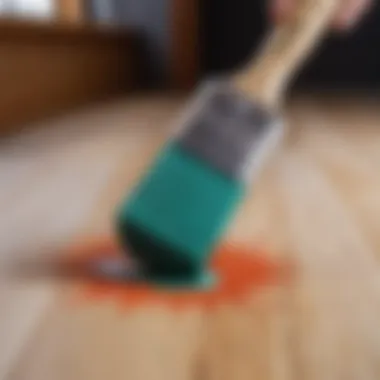

Scrapers and Blades
Scrapers and blades are invaluable in the initial paint removal phase, especially after applying chemical strippers. They allow for controlled and precise paint removal, minimizing the risk of harming the wood.
Key characteristics of scrapers and blades:
- Variety of Blades: Different sizes and strengths allow for various tasks.
- Durable Materials: Stainless steel blades last longer and resist rust.
These tools come in various shapes and sizes, allowing you to select the right scraper for tight corners or large flat areas. It is essential to apply even pressure while scraping to avoid gouging the wood surface. Utilizing scrapers reduces the amount of sanding needed later, preserving the quality of the wood.
Always prioritize understanding the tools required for paint removal. This can significantly affect the outcome of your project, influencing both the efficiency and the final appearance of the restored surface.
Step-by-Step Guide to Remove Paint
The task of removing paint from wooden surfaces can seem daunting, but a structured approach makes it manageable. This guide outlines each essential step to ensure effective paint removal while preserving the integrity of the wood. By following these steps, individuals can minimize the risk of damaging the surface and can achieve a clean finish. The focus is on clarity and practicality, ensuring that even those with limited experience can follow along.
Preparing the Wooden Surface
Cleaning the Surface
Cleaning the surface is a critical first step in the paint removal process. This involves eliminating dust, dirt, and grease that may interfere with paint removal. A clean surface allows the paint remover to make better contact with the paint, leading to more effective results. A common choice for cleaning is to use a mixture of warm water and mild soap, applied with a sponge. This is favored because it does not introduce additional chemicals that might complicate the paint removal process.
After cleaning, it is essential to allow the wood to dry thoroughly before proceeding. If the wood is not dry, the moisture can dilute the paint remover and reduce its effectiveness. Thus, thorough cleaning contributes significantly to achieving the desired outcome in paint removal.
Identifying Paint Type
Identifying the type of paint on the wooden surface is vital for selecting the right paint remover. There are oil-based and water-based paints, each requiring different approaches for removal. Knowing the paint type allows for more tailored and effective treatment.
Oil-based paints may require stronger chemical strippers, while water-based paints can often be removed with more mild solutions. The advantage of this step is that it ensures you do not waste time and resources on ineffective methods. Ultimately, proper identification leads to a more efficient removal process.
Applying the Paint Remover
Method of Application
The method of application is crucial for effective paint removal. Paint removers come in various forms, including liquid, gel, and paste. The choice often depends on the surface area and the thickness of the paint. A gel or paste may adhere better to vertical surfaces, preventing drips and allowing for longer working times.
It is generally recommended to apply the remover with a brush or a cloth in a generous, even coat. This ensures that the product can penetrate the paint effectively. The advantages of a careful application method include minimized waste and enhanced effectiveness, leading to a cleaner surface after paint removal.
Waiting Time
Waiting time is another significant factor. After applying the paint remover, it is essential to allow it sufficient time to work. Timing varies based on the type of remover used and the paint's thickness. Usually, instructions provided by the manufacturer guide this process.
By understanding the importance of waiting, one can achieve optimal results. This step reduces the possibility of having to repeat the process. Well-timed removal leads to a more straightforward and efficient paint removal process.
Removing the Paint
Using Scrapers
Utilizing scrapers is an effective method in the paint removal process. After the paint has loosened due to the paint remover, a scraper helps to lift the old paint off the wood. A plastic or metal scraper can be used, depending on the surface and the type of paint.
The advantage of scrapers is that they allow for precision; one can target specific areas without over-sanding or damaging the wood. However, caution is needed to avoid gouging the wood beneath the paint, which can mar the surface.
Sanding Techniques
Sanding techniques are used as a final step to ensure all paint residues are removed. Sanding can also smooth out any imperfections left from scraping. Fine-grit sandpaper is often recommended, as it provides a delicate finish.
This method is prevalent because it permits greater control over the surface finish. However, it is crucial to sand in the wood grain direction to achieve optimal results and avoid scratches. Proper sanding can lead to an impressive final appearance of the wooden surface.
Post Removal Treatment
After the arduous process of removing paint from wooden surfaces, it is essential to focus on post removal treatment. This stage helps ensure that the wood is not only clean but also protected from future damage. Effective post removal treatment significantly influences the long-term appearance and durability of the wooden surface. By addressing both cleaning and protection, you maintain the wood’s integrity and enhance its natural beauty. Moreover, it sets the foundation for any further aesthetic enhancements or protective applications.
Cleaning the Surface Again
Once the paint has been effectively removed, cleaning the surface again is a fundamental step in the post removal treatment. Residual paint remover or debris can affect the wood’s appearance and future treatment applications. To clean the surface properly, use a mild detergent mixed with water. A soft cloth or sponge is ideal for this task. It ensures that the wood remains unharmed while removing impurities.
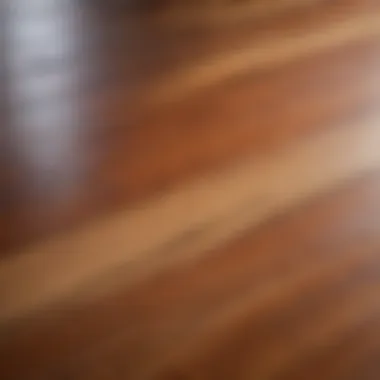

Make sure to rinse thoroughly with clean water and allow the wood to dry completely before proceeding to the next treatment phase. This cleaning step is essential not only for the aesthetic aspect but also for ensuring proper adhesion of any subsequent finishes.
Protecting the Wood After Paint Removal
Protecting the wood after the paint removal is crucial for longevity. The environment can lead to potential damage from moisture, UV rays, and wear. Two methods commonly used for protecting wood surfaces are applying sealants and utilizing finishing techniques.
Applying Sealants
Applying sealants forms a protective layer over the wooden surface. This layer provides resistance against moisture and stains. The key characteristic of sealants is their ability to penetrate the wood fibers, enhancing the overall durability. Sealants are a popular choice because they are easy to apply and often require only a single coat.
A unique feature of sealants is that they are available in various finishes, including matte, satin, or gloss. This variety allows homeowners to maintain or alter the aesthetic of the wood as desired. However, it’s important to consider that sealants need to be reapplied periodically, depending on the exposure to wear and environmental factors.
Finishing Techniques
Finishing techniques, such as staining or varnishing, enhance the wood’s appearance and provide a barrier against damage. The key characteristic of finishing techniques is their versatility. They can enhance the natural beauty of the wood while offering varying levels of protection. This is a beneficial choice because it allows customization according to personal preferences.
Finishing techniques can accentuate the grain of the wood or alter its color, depending on the chosen product. A downside is that some finishes may require more upkeep than sealants and may need to be reapplied more frequently. Understanding the characteristics of each technique will help you in selecting the most suitable option for your wood surfaces.
"Post removal treatment is as critical as the paint removal process itself for maintaining the quality of wooden surfaces."
Common Mistakes to Avoid
Paint removal from wooden surfaces can be a challenging task, and errors can lead to unsatisfactory results or damage to the wood. Recognizing common mistakes before they occur is essential. This section outlines pitfalls to watch out for, ensuring a smooth and effective paint removal process.
Overlooking Surface Preparation
Surface preparation is a critical phase that many may disregard, thinking it is a minor detail in the paint removal process. Neglecting this step can lead to poor bonding of the paint remover and can even cause damage to the wood underneath. A properly prepared surface ensures that the remover will penetrate the paint evenly.
To prepare the surface, start by cleaning it thoroughly to remove dust, dirt, or grease. This not only aids the effectiveness of the paint remover but also helps in avoiding surface scratches when applying mechanical means of removal. Additionally, inspecting for any previous treatments on the wood is necessary. For instance, varnishes or sealers can affect how well the paint remover works.
Remember, adequate preparation can save time and prevent possible damage to the wood.
Neglecting Safety Measures
Safety should never take a backseat during any DIY project. This is particularly true when working with chemical paint removers, which can pose health risks. Many people make the mistake of underestimating the importance of wearing personal protective equipment (PPE). This includes gloves, masks, and safety goggles.
Chemical strippers can release harmful vapors, making adequate ventilation crucial. Failing to ensure proper ventilation could lead to respiratory issues and exposure to toxins.
Before diving into the removal process, take a moment to gather the necessary safety gear. Not only does it protect you, but it also helps maintain focus on the task without distractions from discomfort. Ultimately, prioritizing safety enhances the overall experience and leads to better results.
When to Seek Professional Help
Removing paint from wooden surfaces can be a straightforward task for many. Yet, there are instances where the process can become complex and time-consuming. Knowing when to seek professional help is essential. Professional services possess expertise, experience, and specialized tools that a DIY enthusiast may not have. This section will explore several factors that may indicate the need for professional intervention in paint removal.
Signs that a Professional is Needed
Identifying the signs that necessitate professional care can save you time and prevent potential damage to your wooden items. The following points can help illustrate when to consider bringing in experts:
- Extensive Damage: If the wood beneath the paint is severely damaged or rotting, it may be best to consult a professional. They can properly assess the state of the wood and determine the best approach for restoration.
- Hazardous Materials: In cases where lead paint is present, health risks increase significantly. Professionals are trained to handle such hazardous materials. Their equipment ensures safe removal while following legal guidelines.
- Complex Designs: Intricate or detailed woodwork can be challenging to clean without damaging the structure. Professionals have the skills and tools to carefully navigate these complications.
- Large Areas: Removing paint from extensive wooden surfaces can be physically demanding. If the area is large or involves multiple rooms, hiring a professional can expedite the process and guarantee thorough work.
- Lack of Time: If your schedule is tight, and you cannot dedicate hours to paint removal, it may be a better use of resources to hire a professional. This allows you to focus your time and energy elsewhere.
- Lack of Knowledge or Skills: If you are unfamiliar with the necessary techniques or tools, it may be wise to consult with a professional. They can ensure not only the cleanliness of the job but the safety of the wood as well.
In summary, while many DIY enthusiasts take on paint removal, situations arise where professional help is both practical and prudent. Engaging skilled professionals can ultimately enhance the quality of the work and preserve the integrity of the wooden surfaces.
Epilogue
The conclusion serves as a vital component of this article. It synthesizes the information presented throughout and emphasizes the critical aspects of paint removal from wooden surfaces. Understanding the steps to remove paint effectively is paramount for any DIY enthusiast or homeowner.
Recap of Key Points
To summarize, the essential steps include:
- Assessing the type of paint on the wooden surface.
- Selecting appropriate tools and materials, such as chemical strippers or mechanical tools.
- Following safety precautions, including wearing protective attire and ensuring proper ventilation.
- Executing the paint removal process methodically, from preparation to the final treatment of the wood.
- Addressing common mistakes to avoid a flawed restoration process.
By adhering to these guidelines, one can efficiently restore wooden surfaces to their natural beauty without compromising their integrity.
Encouragement for DIY Enthusiasts
For those who are passionate about home improvement, tackling paint removal can be rewarding. While it might seem daunting, with proper knowledge and preparation, a good outcome is achievable. Embrace the challenge, and remember that mistakes are part of the learning process. Start small and apply what you learn. In time, this venture can enhance not only your skills but also your appreciation for the crafts of restoration and design.
"Experience is the best teacher; through practice, one achieves proficiency."
Investing time in understanding the techniques discussed in this article will assist in achieving professional results. Each method discussed offers unique advantages that cater to different needs and situations. As you embark on future projects, stay committed and persistent. Your efforts will surely lead to satisfying results and ultimately, a more beautiful home.





